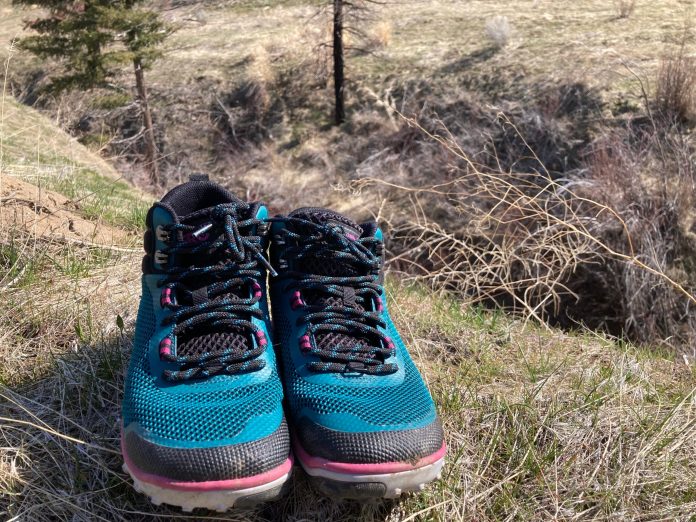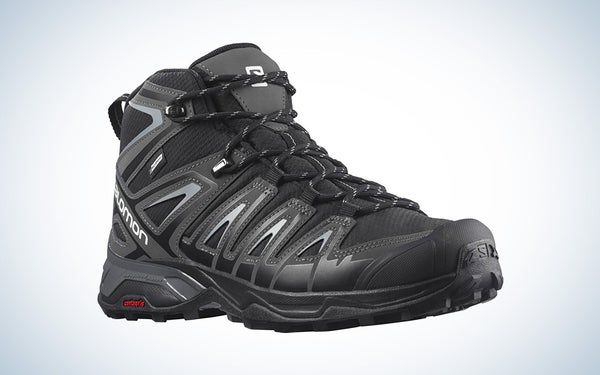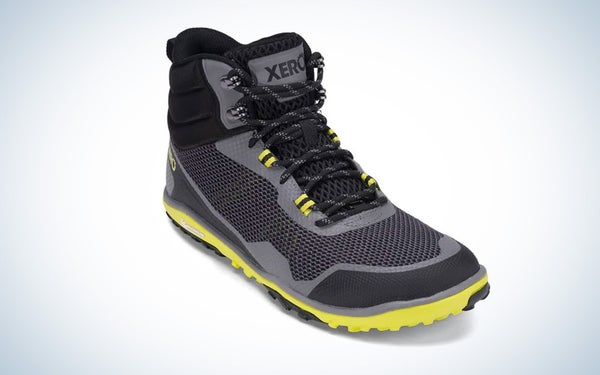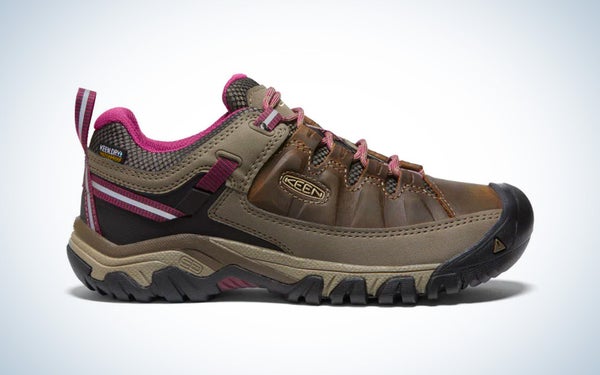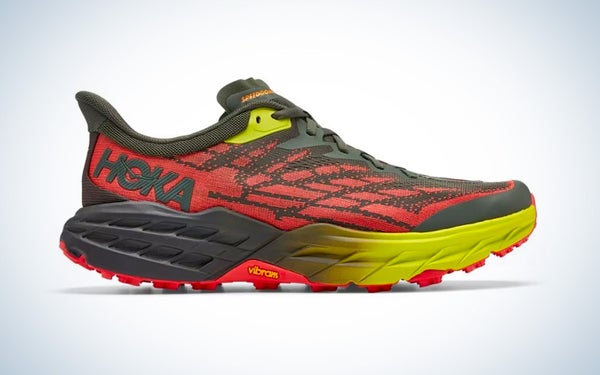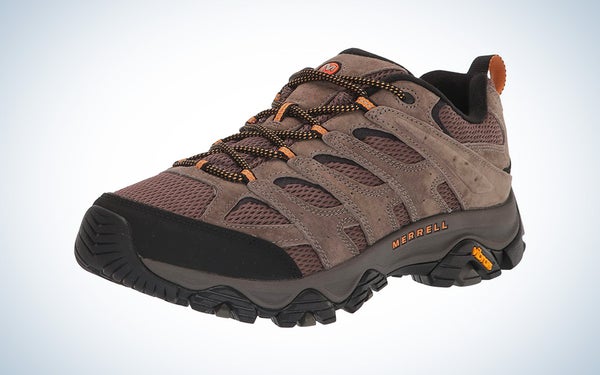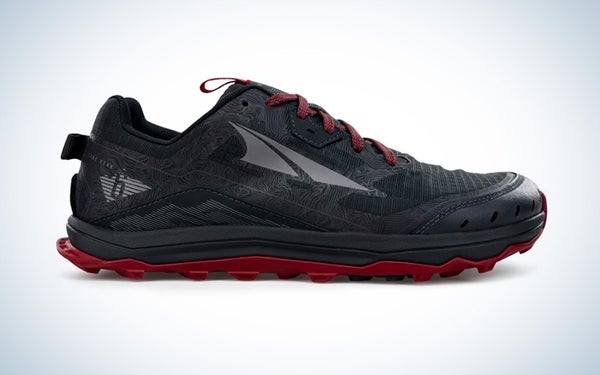We may earn revenue from the products available on this page and participate in affiliate programs. Learn more ›
Published Mar 31, 2023 6:27 PM
Trail hiking shoes are changing the way people think about their treks into the wilderness. The traditional thought that you need a heavy pair of hiking boots with high ankle support for deep walks into the backcountry is shifting as some hikers discover they like lighter footwear with a lower cut. Companies have responded by making shoes that have high performing treads and waterproof qualities that serious hikers demand from their footwear.
The recommendations below are extremely lightweight and comfortable for a variety of hiking scenarios over different types of terrain. These trail hiking shoes are sure to make your outdoor adventures much more enjoyable this year.
How We Picked the Best Trail Hiking Shoes
As a long-time hiker, I have spent plenty of time in the field wearing various forms of hiking footwear, both good and bad. It has given me an idea of the features and designs that will provide the most comfort and help avoid blisters and sores. I also consulted with fellow F&S staff writer Meg Carney for many of these picks. She is an experienced hiker and has an excellent guide to some great hiking boots for anyone looking for something with a little more ankle and arch support.
Additionally, we considered customer reviews, materials, and experiences in our decision making. Some of the factors we considered for each pair of trail hiking shoes include:
- Materials: Are these shoes made from a synthetic material like nylon? A natural material like leather? Are the materials sustainable?
- Tread: What type of terrain was the tread designed for?
- Midsole: What type of material was used for the midsole? What type of hiking is it designed for?
Best Trail Hiking Shoes: Reviews and Recommendations
Best for Women:
Best for Women
Key Features
- Weight: 320 g
- Material: Synthetic
- Sizes: 6-5 to 9-5
Pros
- No break-in period
- Incredible waterproof quality
- Versatile tread for a variety of terrain
Cons
- Narrow toe box
- Doesn’t breathe very well
These shoes were put through the wringer in Minnesota’s Boundary Waters Canoe Area and some more mountainous terrain in the Cascades by F&S Staff Writer Meg Carney, and they quickly became her favorite. She subjected these shoes to some intense rocky terrain as well as days in mud and rain. The Gore-Tex lining doesn’t make these shoes very breathable, but it does make them completely waterproof. For anyone who wants a shoe that’s going to keep your feet dry in the harshest of conditions, this shoe will do it better than just about any other on the market.

In addition to the waterproof quality, these are a good choice for anyone who has problems with blistering. Tecnica gave these shoes a high-quality compression-molded EVA midsole and pre-molded EVA footbed that cushion the feet over a variety of terrain types. This is a good pick for the woman who wants a hiking shoe that can do a little bit of everything.
Best Men’s: Salomon X Ultra Pioneer Mid Climasalomon
Key Features
- Weight: 390g
- Material: Leather/synthetic
- Sizes: 7-14 with half-size options
Pros
- Outsole is great on muddy terrain
- Some arch support in a shoe
- Excellent for wet terrain
Cons
- No version for wide feet
- Insole could be better
Salomon just barely missed out as being our best overall pick for hiking boots. But it is our pick for the best men’s hiking shoe due to its great traction in wet and muddy conditions. This is thanks to the large lugs of the outsole, which are good for gripping in a variety of terrain types. These shoes do provide some support while still having a lower cut and weight than a standard pair of hiking boots. These shoes are fully waterproof, which means they will keep your feet dry at the expense of breathability.
One common complaint is the lack of options available for wide feet. Even people without wide feet have noted these shoes do require a breaking-in period before they became comfortable. However, for the price point, the Salomons are light and built to tackle the worst of what nature throws in your path.
Best for Wide Feet: Xero Shoes Scrambler Mid
Key Features
- Weight: 8.9 ounces each
- Materials: Synthetic
- Sizes: 7-15 (men) and 5-11.5 (women)
Pros
- Spacious toe box
- Excellent traction from tire-inspired treads
- Lightweight
Cons
- Not as much support as other shoes
It’s tough enough finding hiking boots for wide feet. So, it’s not surprising there’s a similar challenge for shoes these days. Fortunately, shoe companies have started to notice the demand and are responding accordingly. The Scrambler has an extremely large toe box that will allow your feet to flex naturally over a variety of terrain. These shoes feature a rather interesting tread design that was designed in conjunction with Michelin tires, the whole idea being to create the equivalent of a mountain bike tire for your feet. The lugs provide some nice grip over rocks and will prevent slipping in muddy areas. As a bonus, Xero Shoes gives the Scrambler Mid outsoles a 5,000-mile warranty, significantly more miles than most boots and shoes are projected to last.

The big downside to the flexibility provided by these shoes is that it comes at the price of support. However, when it comes to comfort for wider feet, these are hard to beat.
Best Waterproof: Keen Targhee III Waterproof
Key Features
- Weight: 16.12 ounces
- Material: Leather and synthetic
- Sizes: 7–15 (men) and 5–11 (women)—half sizes available
Pros
- Chemical-free water treatment
- Has a membrane to retain some breathability
- Durable
Cons
Keen drew some inspiration from modern trail running shoes when designing the Targhee III. These shoes have large, aggressive treads and lugs that grip rocks, mud, and dirt exceptionally well. The Targhee also utilizes leather that stands up to abuse nicely and needs less water to produce. Keen also incorporated PFAs-free water repellent for a more sustainable and environmentally friendly shoe. At the same time, these shoes get over the pitfall of many GTX-based waterproof shoe designs with Keen’s own waterproof membrane. It provides some breathability that many other waterproof hiking shoes lack.
These shoes have an excellent reputation for durability. Their only knock is that they are a little pricey at $120 to $140 a pair, depending on the retailer. Hikers with patience can pick up a pair on sale a few times a year.
Most Comfortable: Hoka Speed Goat 5
Key Features
- Weight: 10.50 ounces each
- Material: Synthetic
- Sizes: 7-15 (men) and 5-12 (women)
Pros
- Sustainable, built from recycled material
- Excellent traction for steeper trails
- Extremely light for longer hikes
Cons
- Narrow tow box
- Vibrant colors aren’t for everyone
Technically, the Hoka Speedgoat 5 is a trail running shoe, but that’s what makes it such a comfortable hiker. The outsoles have a Vibram traction lug designed for speed that also helps to cushion movements over a variety of terrain, especially in steeper areas. Hoka took many of the features people loved about their Speedgoat 4 shoes and migrated them over with some slight improvements to create these shoes. Most notable here is that the entire pair only weighs 1 pound, 4.6 ounces. For anyone looking for a pair of shoes that will keep them light on their feet, this is a great choice.
The main complaint with these shoes is the narrow toe box. Some people simply don’t find it comfortable. These shoes are also going to divide hikers based on their extremely vibrant colors. Some people will think they are garish, and others will love them.
Best Budget: Merrell Moab 3
Key Features
- Weight: 11.6 ounces each
- Materials: Leather and recycled webbing, mesh, and laces
- Sizes: 7–14 (men) and 5–13 (women)
Pros
- Medium and wide widths available
- Affordable
- Sustainably made
Cons
Merrell offers a lot of value in the Moab 3. Most notable are the Vibram TC5+ outsoles, which help give these boots a ton of traction in a variety of terrain and conditions. In our experience, these types of outsoles usually make boots and shoes more expensive than this. These shoes also have a solid construction using a combination of leather and recycled webbing, mesh, and laces.
The downside to these shoes is that they are a little heavier than some of the other options on this list. However, for the price, these shoes are a great deal, especially since there is a wide-width version. Merrell also makes a model with Pig Suede leather and a waterproof membrane for anyone looking for protection against wet feet.
Best Lightweight: Xero Shoes DayLite Hiker Fusion
Key Features
- Weight: 1.5 pounds (pair)
- Material: Synthetic
- Sizes: 6.5-15 (men) and 5-12 (women)
Pros
- Extremely comfortable footbed
- Non-elevated heel provides a more natural feel
- Minimalist design is great for casual hikers
Cons
- Not ideal for more challenging hikes
This is one of the most comfortable pairs of shoes on the market today. The DayLites have a heel that is flat and level with the inner drop sole for a more natural stance while walking. The footbed is also wide and cushy. The idea is to allow the foot to operate more naturally inside the shoe. Combine that concept with the light weight, and you have a minimalist pair of hiking shoes that is perfect for a variety of hiking scenarios.
Even though these shoes are built for all sorts of terrain, they are not ideal for super challenging or technical hikes. They are a great choice for the casual hiker, but diehards might find they wear out a little faster than other lightweight options.
Best for Backpacking: Altra Lone Peak 6
Key Features
- Weight: 1 pound, 5 ounces
- Material: Synthetic
- Sizes: 7.5-12.5 (men) and 5.5-12 (women)
Pros
- Regular and wide footbeds available
- Footbed is cushy for added backpack weight
- Breathable mesh keeps feet cool on warm days
Cons
- Some longer-term durability concerns
Many backpackers and thru-hikers are starting to move towards hiking shoes over boots simply for the weight factor. Most hikers are already carrying around plenty of weight on their backs, and consequently, some lightweight shoes like the Altra Lone Peak 6s will make things easier on their feet since they only weigh 1 pound, 5 ounces. These shoes are also known for their wide footbed, which helps distribute not only the weight of the hiker, but the weight of their pack too. These shoes also have a wide tread designed to grip in all directions. That tread is perfect for traversing up and down slopes, whether they be muddy, dry, or somewhere in between. These shoes have become very popular with thru-hikers, but we have also heard reports of durability issues.
Things to Consider Before Buying the Best Trail Hiking Shoes
When deciding on the types of hiking boots that best suit your needs, there are a variety of factors to consider that help ensure a better fit. Generally, these considerations will help you pick shoes that will last longer for the scenarios where you plan to use them the most.
Construction
The main reason most people have a miserable experience with hiking footwear is simply that they are wearing the wrong shoes or boots for the situation. While others shop for this type of footwear in the same way they would a casual pair of tennis shoes or work shoes. There are many construction factors to consider when choosing a pair of hiking shoes. These include:
- Waterproofing: It doesn’t make a lot of sense to go for a full Gore-Tex waterproofed shoe if you are planning most of your hikes in a desert environment. In fact, it could make the experience much more unpleasant if your feet are sweating and retaining that moisture through your hike. Sweating and moisture lead to more blisters and sore feet. On the flip side of the coin, a shoe that breathes too much can make for a soggy, miserable experience with soaked socks in tall wet grass or a trail with a lot of creek crossings.
- Tread: The analogy of shoe treads and tires made by Xero Shoes in the recommendations above is a good one. Off-road vehicles are often fitted with drastically different tires for mud-bogging, sand, or hard-packed trails. The concept is mostly the same with footwear. If you anticipate mud, look for treads with larger and deeper lugs. Rock scrambling calls for a stickier and smaller tread. With hard-packed trails, you can get away with a more minimalist design like the DayLite Hiker Fusion.
- Midsole: If you’re new to hiking footwear, you’ve probably noticed the extra emphasis on midsoles by shoe manufacturers. Think of the midsole as a shock absorber or suspension on a car. Except with a shoe, it is the middle layer between the insole that contacts your foot and the outsole that contacts the ground. Generally, an EVA foam midsole is usually much softer and cushier than a polyurethane (PU) midsole. While PU midsoles lose some of that comfort factor, they are usually much more durable than EVA foam.
Other Considerations
In addition to the construction and materials of the shoe, there are a few other minor factors that frequently get overlooked by newer hikers before their first big excursion.
- Sizing: Generally, it is never a bad idea to buy one size larger than your usual shoe size for hiking. However, there is a more recent trend of hiking footwear moving towards “true sizing,” which is exactly what it sounds like, a size 11 is an 11, and so forth for other sizes. Pay attention to the fine print while buying to determine if you need to size up. Many manufacturers have also subsequently moved towards offering half-size options that allow a better fit if you do need to size up without needing to resort to thicker socks. Generally, you will want the boots to be snug without being overly tight. Make sure you can move your toes around in the toe box for the best fit.
- Pack Weight: If you are planning to use your shoes for backpacking or rucking, you will want shoes that have a comfortable insole that will cushion your feet and help distribute the weight evenly. A quality midsole helps absorb the shock of the extra weight and will make each step much easier. Most hikers will find a PU (polyurethane) midsole better for hiking with a hefty pack than EVA foam simply because it is built with extra durability in mind.
FAQs
Q: Are barefoot shoes good for hiking?
Minimalist barefoot shoes can be good for hiking, although this type of shoe is usually best for experienced hikers. Barefoot shoes don’t offer as much cushioning and support as normal shoes, and it can take a while to get used to them. Barefoot shoes work the muscles of the foot significantly more which makes them a good choice for anyone wanting to build up strength in their feet. But this type of shoe does not offer as much support or protection from sharp rocks and sticks on the forest floor.
Q: Can I wear trail shoes as everyday shoes?
Some people have found they prefer trail shoes to normal tennis shoes for casual everyday use at work or at home. Many forms of hiking shoes have larger outsoles and midsoles than standard shoes, which can provide more cushioning and protection for anyone who is on their feet for work all day. Subsequently, the downside is that pavement and concrete can wear down the soles faster and shorten the lifespan of the shoe.
Q: What is the difference between trail shoes and hiking shoes?
The line has blurred a bit between the different types of hiking footwear in the last few years. However, most dedicated trail footwear tends to be more focused on comfort. Trail hiking shoes are usually marketed toward runners, so this makes sense. Running puts much more strain and abuse on the joints than walking. Hiking shoes tend to offer better support than trail shoes, making them better suited for backpacking or thru-hiking than trail shoes. The treads on hiking shoes tend to be a little more aggressive than trail shoes.
Q: Hiking shoes vs hiking boots, which is better?
This depends entirely on how you plan to use your footwear. Basically, hiking boots are better for steeper and more technical terrain than shoes. Consequently, hiking shoes are much lighter and more comfortable than boots. Shoes usually breathe better than boots, which use thicker materials. Boots offer the best support for your arches and ankles, which become major factors when camping with a heavy backpack.
The Best Trail Hiking Shoes: Final Thoughts
The Tecnica and Salomon were easy choices for the top pick for women’s and men’s hiking shoes. Both shoes have a solid reputation in the hiking community for comfort and reliability. And they are versatile for a variety of scenarios. For anyone looking for a quality shoe that will help them tackle all types of terrain, it’s hard to go wrong with either option.
Why Trust Us
For more than 125 years, Field & Stream has been providing readers with honest and authentic coverage of outdoor gear. Our writers and editors eat, sleep, and breathe the outdoors, and that passion comes through in our product reviews. You can count on F&S to keep you up to date on the best new gear. And when we write about a product—whether it’s a bass lure or a backpack—we cover the good and the bad, so you know exactly what to expect before you decide to make a purchase.

